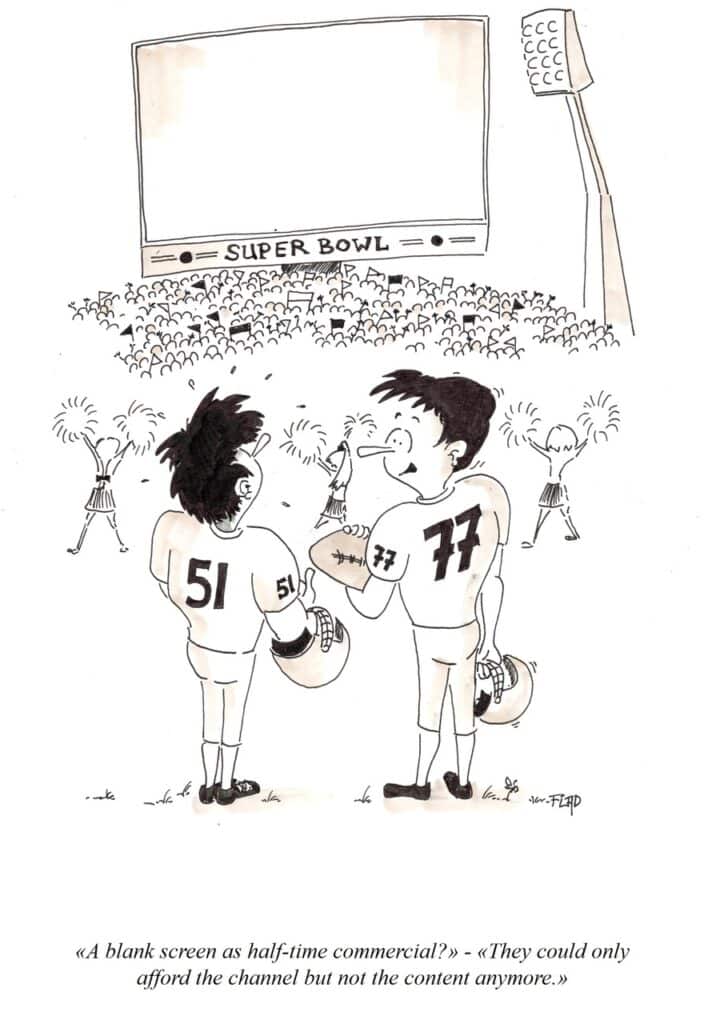It’s the age-old question that still comes up when discussing splitting budgets across channel and content (AKA media and creative), or when marketing procurement teams are tasked with reducing working versus non-working spending (AKA media and creative). What is more important?
While the simple answer is ‘both’ (and my cartooning colleague Dennis Flad takes this to an amusing extreme) the question on the degree of investment remains.

By Dennis Flad
Yes of course both are important, depending on the context, but they are not always equally important. And it is instructive to look at where and why.
Take the concept of working versus non-working marketing spend. Beyond the obvious problem with defining the parameters, (again, media without content is pointless) the fact is that the usual conversations around working to non-working ratios are about reducing non-working spend and maximising working investment.
As the money flows to where there is perceived value, does this mean channel is perceived as more important than content? Or is it because media appears to be more accountable – in that you can count the number of impressions, or GRP, or TARPs, or whatever you are buying against – and so it seems better value than one ad with one idea?
Of course, there are channels that do not require money at all. Remember the old concept of ‘viral’ video content? Agencies were offering their clients the opportunity to earn millions of dollars in effective media value with the investment in a ‘viral video’.
Unfortunately, it was more miss than hit. Today, most viral video strategies seem to come with either a heavy influencer price-tag or significant media investment to make sure someone (other than the agency and production team) see it. Not exactly a great investment.
There was a time when investment in media was around ten times the investment in content. Back in the broadcast dominated days, ten percent of the media budget was allocated for production. This did not allow for the time and money for the strategy and creative idea, just the production.
With the rise of owned, earned, and shared media spend that went the way of Sunday night campaign launches and network road-blocking. But media spend, across the increasingly complex choice of channels, still demands a significantly larger level of investment than the content that runs in those channels, suggesting the value is still in the media.
Then again, if time is money, then marketers and their agencies still spend a lot more time reviewing creative strategy and execution than they do planning and buying media. Hours will be spent at every step of the creative process from discussing strategy and insights to reviewing any number of creative territories, concepts and platforms, down to never-ending changes in the details of the execution, including the text (copy), the images and layout (art direction and design). This is all before you go into production.
But perhaps the real issue here is that content production is ultimately going to be the visible component of media channel choice. When the topic of working in the advertising industry comes up in social situations, people are more likely to refer to content they liked rather than the channel they saw it in. (It also explains why media awards need judges that understand media and don’t just vote based on the content.)
Perhaps the most insightful perspective on this question can be answered by science and the work of Dr. Karen Nelson-Field on attention and the way media works. Looking at the same creative shown across multiple channels has shown that media choice has an impact on audience attention. So, if you are after audience attention, then media choice is imperative.
But she goes on to say that the content, or the creative, is essential in converting that attention into action, whether that is consideration, evaluation, or purchase.
So, there you go. The real answer to the question of what is more important, media or creative is not just both, but that both play different but essential roles in closing the deal.
See Also: Woolley Marketing: Is marketing an art or a science?
–
Darren Woolley is Global CEO of TrinityP3, Australia’s largest and most influential independent marketing / pitch consultancy and is well known to the advertising industry. Founded more than 20 years ago TrinityP3 has a significant presence in Australia where it leads the pitch process for many of the country’s leading advertising accounts as well as having offices in London, New York and Zurich.

Darren Woolley
Dennis Flad is responsible for Trinity P3 EMEA and founder of t’charta, a management consultancy boutique for strategic product management, pricing and go-to-market based in Zurich, Switzerland. Dennis worked his entire life in marketing and advertising, which allows him to infuse his whimsical drawings with a realistic understanding of management practices and behaviours.

Dennis Flad

